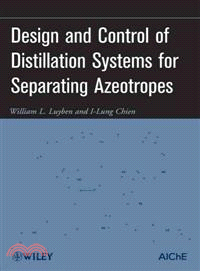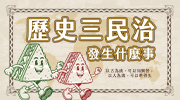Design And Control Of Distillation Systems For Separating Azeotropes
商品資訊
ISBN13:9780470448625
出版社:John Wiley & Sons Inc
作者:Luyben
出版日:2010/03/23
裝訂/頁數:精裝/472頁
規格:26.0cm*18.4cm*3.2cm (高/寬/厚)
定價
:NT$ 6838 元優惠價
:90 折 6154 元
若需訂購本書,請電洽客服 02-25006600[分機130、131]。
商品簡介
作者簡介
目次
相關商品
商品簡介
Hands-on guidance for the design, control, and operation of azeotropic distillation systems
Following this book's step-by-step guidance, readers learn to master tested and proven methods to overcome a major problem in chemical processing: the distillation and separation of azeotropes. Practical in focus, the book fully details the design, control, and operation of azeotropic distillation systems, using rigorous steady-state and dynamic simulation tools.
Design and Control of Distillation Systems for Separating Azeotropes is divided into five parts:
Fundamentals and tools
Separations without adding other components
Separations using light entrainer (heterogeneous azeotropic distillation)
Separations using heavy entrainer (extractive distillation)
Other ways for separating azeotropes
The distillation methods presented cover a variety of important industrial chemical systems, including the processing of biofuels. For most of these chemical systems, the authors explain how to achieve economically optimum steady-state designs. Moreover, readers learn how to implement practical control structures that provide effective load rejection to manage disturbances in throughput and feed composition.
Trade-offs between steady-state energy savings and dynamic controllability are discussed, helping readers design and implement the distillation system that best meets their particular needs. In addition, economic and dynamic comparisons between alternative methods are presented, including an example of azeotropic distillation versus extractive distillation for the isopropanol/water system.
With its focus on practical solutions, Design and Control of Distillation Systems for Separating Azeotropes is ideal for engineers facing a broad range of azeotropic separation problems. Moreover, this book is recommended as a supplemental text for undergraduate and graduate engineering courses in design, control, mass transfer, and bio-processing.
Following this book's step-by-step guidance, readers learn to master tested and proven methods to overcome a major problem in chemical processing: the distillation and separation of azeotropes. Practical in focus, the book fully details the design, control, and operation of azeotropic distillation systems, using rigorous steady-state and dynamic simulation tools.
Design and Control of Distillation Systems for Separating Azeotropes is divided into five parts:
Fundamentals and tools
Separations without adding other components
Separations using light entrainer (heterogeneous azeotropic distillation)
Separations using heavy entrainer (extractive distillation)
Other ways for separating azeotropes
The distillation methods presented cover a variety of important industrial chemical systems, including the processing of biofuels. For most of these chemical systems, the authors explain how to achieve economically optimum steady-state designs. Moreover, readers learn how to implement practical control structures that provide effective load rejection to manage disturbances in throughput and feed composition.
Trade-offs between steady-state energy savings and dynamic controllability are discussed, helping readers design and implement the distillation system that best meets their particular needs. In addition, economic and dynamic comparisons between alternative methods are presented, including an example of azeotropic distillation versus extractive distillation for the isopropanol/water system.
With its focus on practical solutions, Design and Control of Distillation Systems for Separating Azeotropes is ideal for engineers facing a broad range of azeotropic separation problems. Moreover, this book is recommended as a supplemental text for undergraduate and graduate engineering courses in design, control, mass transfer, and bio-processing.
作者簡介
WILLIAM L. LUYBEN, PhD, is a professor at Lehigh University. Dr. Luyben has published more than 220 technical papers in process control and design and is the author or coauthor of eleven textbooks. In addition, he has nine years of industrial experience, working with Exxon and DuPont.
I-LUNG CHIEN, PhD, is a professor at National Taiwan University of Science and Technology with research interests in design and control of chemical, polymer, and bio-processes. He was a senior consulting engineer for DuPont Engineering for nine years, where he performed research and consultation for various chemical processes. Dr. Chien has published more than fifty technical papers in process control and design.
I-LUNG CHIEN, PhD, is a professor at National Taiwan University of Science and Technology with research interests in design and control of chemical, polymer, and bio-processes. He was a senior consulting engineer for DuPont Engineering for nine years, where he performed research and consultation for various chemical processes. Dr. Chien has published more than fifty technical papers in process control and design.
目次
PREFACE.
ACKNOWLEDGEMENTS.
PART 1 FUNDAMENTALS AND TOOLS.
1 INTRODUCTION.
1.1 History.
1.2 Applications.
1.3 Literature.
1.4 Multiple Steady States.
References.
2 PHASE EQUILIBRIUM.
2.1 Phase Equilibrium Relationships.
2.2 Equations Describing Phase Equilibrium Relationships.
2.3 Diagrams For Binary Systems.
2.4 Ternary Diagrams.
2.5 Data Regression.
2.6 Group Contribution Method.
2.7 Conclusion.
References.
3 STEADY-STATE DESIGN IN ASPEN PLUS.
3.1 Building a Steady-State Model.
3.2 Unit Operation Blocks Used in this Book.
3.3 Add a Nondatabank Component.
3.4 Conclusion.
References.
4 DYNAMICS AND CONTROL IN ASPEN DYNAMICS.
4.1 Sizing of Process Vessels.
4.2 Sizing of Pumps, Compressors, and Control Valves.
4.3 Controllers and Dynamic Elements.
4.4 Controller Tuning.
4.5 Ratio and Cascade Control.
4.6 Conclusion.
PART 2 SEPARATIONS WITHOUT ADDING OTHER COMPONENTS.
5 PRESSURE-SWING AZEOTROPIC DISTILLATION.
5.1 Tetrahydrofuran–Water System.
5.2 Acetone–Methanol System.
5.3 Pentane–Methanol System.
5.4 Conclusion.
References.
6 PRESSURE SWING WITH HEAT INTEGRATION.
6.1 THF–Water System Steady-State Design with Heat Integration.
6.2 THF–Water System Dynamics and Control.
6.3 Heat Integration in an Acetone–Methanol System.
6.4 Conclusion.
References.
7 HETEROGENEOUS BINARY AZEOTROPES.
7.1 n-Butanol-Water System.
7.2 Phase Equilibrium.
7.3 Steady-State Design.
7.4 Dynamics and Control.
7.5 Conclusion.
References.
PART 3 SEPARATIONS USING A LIGHT ENTRAINER (HETEROGENEOUS AZEOTROPIC DISTILLATION).
8 ISOPROPANOL–WATER (CYCLOHEXANE AS THE ENTRAINER).
8.1 Feasible Column Sequence for the Separation.
8.2 Steady-State Design of an Isopropanol–Water System.
8.3 Overall Control Strategy Development.
8.4 Conclusion.
References.
9 ACETIC ACID–WATER (ISOBUTYL ACETATE AS THE ENTRAINER).
9.1 Comparison of Three Candidate Entrainers.
9.2 Control Strategy Development.
9.3 Industrial Column with Preliminary Dynamic Simulations.
9.4 Industrial Column with Continuous Side-Stream Draw Off.
9.5 Side Draw with a Practical Automatic Purging Strategy.
9.6 Conclusion.
References.
PART 4 SEPARATIONS USING HEAVY ENTRAINER (EXTRACTIVE DISTILLATION).
10 ISOPROPANOL-WATER (DIMETHYL SULFOXIDE AS THE ENTRAINER).
10.1 Comparing Entrainers: Dimethyl Sulfoxide Versus Ethylene Glycol.
10.2 Steady-State Design and Economical Analysis.
10.3 Overall Control Strategy Development.
10.4 Conclusion.
References.
11 EXTRACTIVE DISTILLATION OF THE ACETONE-METHANOL SYSTEM.
11.1 Acetone–Methanol–Water Phase Equilibrium.
11.2 Steady-State Design.
11.3 Dynamics and Control.
11.4 Heat-Integrated System.
11.5 Effect of Solvent on Controllability.
11.6 Conclusion.
References.
12 MAXIMUM-BOILING AZEOTROPES.
12.1 Acetone–Chloroform System Steady-State Design.
12.2 Dynamics and Control.
12.3 Conclusion.
Reference.
PART 5 OTHER WAYS FOR SEPARATING AZEOTROPES.
13 BATCH DISTILLATION OF AZEOTROPES.
13.1 Batch Extractive Distillation (Acetone–Methanol with Water as the Entrainer).
13.2 Batch Extractive Distillation (Isopropanol–Water with DMSO as the Entrainer).
13.3 Acetic Acid Dehydration Via Heteroazeotropic Batch Distillation.
13.4 Multivessel Heteroazeotropic Batch Distillation.
13.5 Conclusion.
References.
14 HYBRID DISTILLATION–PERVAPORATION SYSTEMS.
14.1 Introduction.
14.2 Pervaporation Model.
14.3 Pervaporation–Column System.
14.4 Dynamics and Control.
14.5 Process Modification.
14.6 Conclusion.
References.
INDEX.
ACKNOWLEDGEMENTS.
PART 1 FUNDAMENTALS AND TOOLS.
1 INTRODUCTION.
1.1 History.
1.2 Applications.
1.3 Literature.
1.4 Multiple Steady States.
References.
2 PHASE EQUILIBRIUM.
2.1 Phase Equilibrium Relationships.
2.2 Equations Describing Phase Equilibrium Relationships.
2.3 Diagrams For Binary Systems.
2.4 Ternary Diagrams.
2.5 Data Regression.
2.6 Group Contribution Method.
2.7 Conclusion.
References.
3 STEADY-STATE DESIGN IN ASPEN PLUS.
3.1 Building a Steady-State Model.
3.2 Unit Operation Blocks Used in this Book.
3.3 Add a Nondatabank Component.
3.4 Conclusion.
References.
4 DYNAMICS AND CONTROL IN ASPEN DYNAMICS.
4.1 Sizing of Process Vessels.
4.2 Sizing of Pumps, Compressors, and Control Valves.
4.3 Controllers and Dynamic Elements.
4.4 Controller Tuning.
4.5 Ratio and Cascade Control.
4.6 Conclusion.
PART 2 SEPARATIONS WITHOUT ADDING OTHER COMPONENTS.
5 PRESSURE-SWING AZEOTROPIC DISTILLATION.
5.1 Tetrahydrofuran–Water System.
5.2 Acetone–Methanol System.
5.3 Pentane–Methanol System.
5.4 Conclusion.
References.
6 PRESSURE SWING WITH HEAT INTEGRATION.
6.1 THF–Water System Steady-State Design with Heat Integration.
6.2 THF–Water System Dynamics and Control.
6.3 Heat Integration in an Acetone–Methanol System.
6.4 Conclusion.
References.
7 HETEROGENEOUS BINARY AZEOTROPES.
7.1 n-Butanol-Water System.
7.2 Phase Equilibrium.
7.3 Steady-State Design.
7.4 Dynamics and Control.
7.5 Conclusion.
References.
PART 3 SEPARATIONS USING A LIGHT ENTRAINER (HETEROGENEOUS AZEOTROPIC DISTILLATION).
8 ISOPROPANOL–WATER (CYCLOHEXANE AS THE ENTRAINER).
8.1 Feasible Column Sequence for the Separation.
8.2 Steady-State Design of an Isopropanol–Water System.
8.3 Overall Control Strategy Development.
8.4 Conclusion.
References.
9 ACETIC ACID–WATER (ISOBUTYL ACETATE AS THE ENTRAINER).
9.1 Comparison of Three Candidate Entrainers.
9.2 Control Strategy Development.
9.3 Industrial Column with Preliminary Dynamic Simulations.
9.4 Industrial Column with Continuous Side-Stream Draw Off.
9.5 Side Draw with a Practical Automatic Purging Strategy.
9.6 Conclusion.
References.
PART 4 SEPARATIONS USING HEAVY ENTRAINER (EXTRACTIVE DISTILLATION).
10 ISOPROPANOL-WATER (DIMETHYL SULFOXIDE AS THE ENTRAINER).
10.1 Comparing Entrainers: Dimethyl Sulfoxide Versus Ethylene Glycol.
10.2 Steady-State Design and Economical Analysis.
10.3 Overall Control Strategy Development.
10.4 Conclusion.
References.
11 EXTRACTIVE DISTILLATION OF THE ACETONE-METHANOL SYSTEM.
11.1 Acetone–Methanol–Water Phase Equilibrium.
11.2 Steady-State Design.
11.3 Dynamics and Control.
11.4 Heat-Integrated System.
11.5 Effect of Solvent on Controllability.
11.6 Conclusion.
References.
12 MAXIMUM-BOILING AZEOTROPES.
12.1 Acetone–Chloroform System Steady-State Design.
12.2 Dynamics and Control.
12.3 Conclusion.
Reference.
PART 5 OTHER WAYS FOR SEPARATING AZEOTROPES.
13 BATCH DISTILLATION OF AZEOTROPES.
13.1 Batch Extractive Distillation (Acetone–Methanol with Water as the Entrainer).
13.2 Batch Extractive Distillation (Isopropanol–Water with DMSO as the Entrainer).
13.3 Acetic Acid Dehydration Via Heteroazeotropic Batch Distillation.
13.4 Multivessel Heteroazeotropic Batch Distillation.
13.5 Conclusion.
References.
14 HYBRID DISTILLATION–PERVAPORATION SYSTEMS.
14.1 Introduction.
14.2 Pervaporation Model.
14.3 Pervaporation–Column System.
14.4 Dynamics and Control.
14.5 Process Modification.
14.6 Conclusion.
References.
INDEX.
主題書展
更多
主題書展
更多書展今日66折
您曾經瀏覽過的商品
購物須知
外文書商品之書封,為出版社提供之樣本。實際出貨商品,以出版社所提供之現有版本為主。部份書籍,因出版社供應狀況特殊,匯率將依實際狀況做調整。
無庫存之商品,在您完成訂單程序之後,將以空運的方式為你下單調貨。為了縮短等待的時間,建議您將外文書與其他商品分開下單,以獲得最快的取貨速度,平均調貨時間為1~2個月。
為了保護您的權益,「三民網路書店」提供會員七日商品鑑賞期(收到商品為起始日)。
若要辦理退貨,請在商品鑑賞期內寄回,且商品必須是全新狀態與完整包裝(商品、附件、發票、隨貨贈品等)否則恕不接受退貨。
























